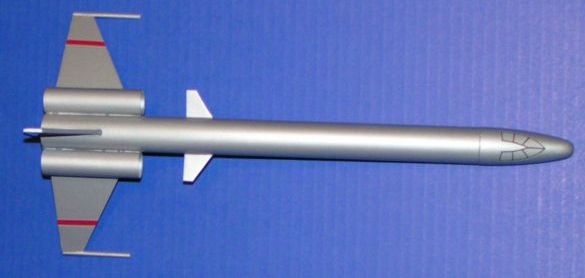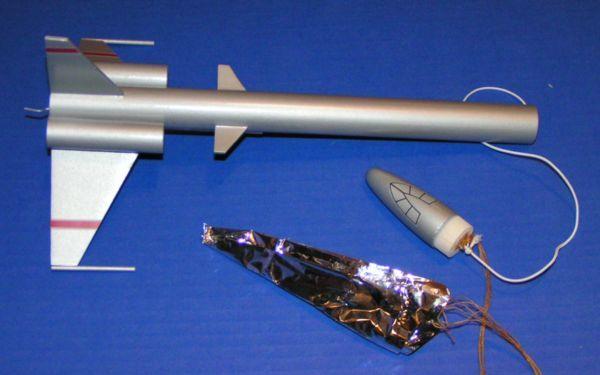Starlight Rockets F-32 Avenger
Starlight Rockets - F-32 Avenger {Kit} (8486)
Contributed by Nick Esselman
| Construction Rating: | starstarstarstar_borderstar_border |
| Flight Rating: | starstarstarstarstar_border |
| Overall Rating: | starstarstarstar_borderstar_border |
| Diameter: | 1.00 inches |
| Length: | 14.75 inches |
| Manufacturer: | Starlight Rockets |
| Skill Level: | 3 |
| Style: | Futuristic/Exotic |
I first saw Starlight Model Rockets advertised in NAR's Sport Rocketry magazine, but was then pleased to see JonRocket.com start to carry them, so I could try one out. The flight vehicle that I tried out is their F-32 Avenger. The winged-aircraft look is what caught my attention.
The kit includes one 12" body tube which seems slightly thicker than typical Estes (but when I measured them I could not see a difference). This body tube was completely pre-marked. The 2 3/4" nose cone and pre-cut fins are balsa. There are two 18mm "jet" tubes that are 2 3/4" long. An 1/8" dowel is provided for some detail work. There is an 18mm motor tube with retaining hook, thrust ring, and two centering rings. The recovery system is made up of an 12" ASP Mylar parachute, a 16" piece of round (1/16") white elastic, and a shock cord mount. A 1/8" launch lug, some hardware, a decal sheet finish out the kit.

CONSTRUCTION:
The instructions are printed on a 3 sides of two 8½ x 11" paper. There are many hand drawn illustrations to assist in building the kit and the placement of the decals. As mentioned above, the body tube is pre-marked with a few different colors, so a marking guide is not needed.
The F-32 assembles like most Estes, Custom, or Quest kits.
The motor mount is assembled first and it used a wire motor hook, thrust ring and two centering rings. The thin round motor hook has a tendency to "roll" in the motor mount when being used. I believe this is why Estes and Quest went with flat spring steel. Nonetheless, it is nice to have a motor hook provided.
The nose cone is balsa and it first requires that an eye-screw be added into the base. The nose cone was really grainy. I found the bottom transition edge (from nose cone to shoulder) to be very ragged and slight splintered. Not terribly uncommon for balsa nose cone kits, but it is tough to sand. I found that by sliding it into the body tube, applying pressure and turning it against the tube edge greatly helped reduce the raggedness problem.
Having pre-cut balsa fins is a nice quality touch. The body tube is pre-marked with different colors to allow for very easy assembly. The instructions guide you to use the "double" glue technique. Glue is added to the root edge of the fin and then it is set aside to dry. Starlight has even gone as far as coloring the root edge with black. Once it is dry, glue is applied to the root edge and it is placed in position on the pre-marked line on the body tube.
The 1/8" dowel is cut into two 2" and two 3" pieces. The 2" dowels are glued to the end of the wing tips. The 3" dowels are glued on the underside of the rocket on each side of the launch lug. These add detail to the rocket.
The shock cord gets a knot tied in one end and it then weaved through three holes in the shock cord mount. This is then glued inside, 1" down from the top, of the body tube. The opposite end is tied to the eye-screw in the nose cone. The parachute is assembled according to ASP's instructions.
Basic finishing instructions are provided (sanding sealer, sand, repeat, paint white). Then the instructions describe applying the water-slide decals. However, there was a supplemental note that said water-slide decals had been replaced with peel-n-stick ones. So I peeled-n-stuck on the decals.
I used my typical multiple coats of Plastic-Kote Primer and sanding in-between. The nose cone took a lot of work. I then used Walmart Silver paint.
Overall, for CONSTRUCTION I would rate this kit 3 points. The instructions are adequate for the kit. The hand drawings are not the same quality of other kits, but certainly allow the builder to be successful. The quality of parts are good with the exception of the nose cone and motor hook. The pre-marking is a very thoughful bonus. Having decals and Mylar parachute are nice features, too.

 FLIGHT/RECOVERY:
FLIGHT/RECOVERY:
Starlight recommends the A8-3, B6-4, and C6-5.
My finished rocket weighed 1.5 ounces.
The instructions indicate that you'll need 2-4 squares of wadding. I used 3, rolled my 'chute, and got everything ready.
The first flight was on an A8-3. Excellent first choice. Not terribly high, but allowed for a nice flight. Recovery system worked fine, no damage.
The second flight was on a B6-4. Straight flight, very stable. It ejected at apogee. I was a fairly high flight for the size of rocket it is. Descent rate is good. Upon collection of the rocket from the field, I discovered the first feared "Estes dent".
I know, it probably isn't fair to keep saying "Estes dent", but I think most understand what that is. Too short of a shock cord, elastic stretches, snaps back. On balsa nose cones you get a "smile" from the body tube. With plastic nose cones you get a "dent" on the top of the body tube. Therefore, I now declare this to be a "balsa smile" instead of an "Estes dent".
So, back to the program. The flight resulted in a "balsa smile".
The third flight was also on a B6-4. Stable and straight. At apogee it turned as if the rocket (plane) was flying right side up. Neat to see.
 The fourth flight was on a C6-7. I purposely chose the longer delay so it could drop some before ejection. It looked great arcing over, but it was way up there. The ejection charge went off and the parachute did not fully open. I'm glad because I would have had to walk a mile. A second "balsa smile" appeared.
The fourth flight was on a C6-7. I purposely chose the longer delay so it could drop some before ejection. It looked great arcing over, but it was way up there. The ejection charge went off and the parachute did not fully open. I'm glad because I would have had to walk a mile. A second "balsa smile" appeared.
For FLIGHT/RECOVERY, I would rate this rocket 4 points. The F-32 is very stable and nice looking. The short elastic shock cord caused damage. The parachute is excellent and sized correctly for this rocket.
I give the rocket an OVERALL rating of 3 ½ points. Looks and what you get with kit are very nice. Overall, it was a good experience, but in all fairness, the rocket falls into the "average plus" range for ratings.
 |
 |
Flights
Sponsored Ads
 |
 |








